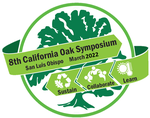#36

Will Oak Populations Migrate? The role of vicariance in California Oak Distributions
Thomas Scott, UC Cooperative Extension, Department of Environmental Science Policy and Management, UC Berkeley, and Department of Earth Sciences, UC Riverside
Andrew Sanders, Curator, UC Riverside Herbarium, University of California Riverside
Scott Mensing, Department of Geography, University of Nevada, Reno
A number of studies have estimated the impacts of climate change on oak distributions, framed by questions of how far or fast oaks populations will need to migrate to survive. While the fossil record and phylogenies suggest that lineages of oaks (Quercus kelloggii, Q. lobata, Q. chrysolepis) moved south into California as climate changed in the Paleocene, there are equally compelling arguments for role of vicariance and barriers in the history of modern oak species distributions in the United States and Mexico. One of the strongest barriers to current oak distributions in California occurs in the Sonoran Desert and Baja California Norte, where oak lineages from the California Floristic Province (CFP) meet lineages from the southwestern US and Mexico. This barrier forms a Wallace’s line for Q. section Quercus and Q. section Lobatae, crossed by only 3 (of 44) species from Mexican oak lineages (Q. turbinella, Q. englemannii, Q. peninsularis), and no species from the CFP (16 species). The most intriguing part of this separation occurs across the Gulf of California, where the movements of the Pacific and North American plates have created one of best studied vicariant events in North American biogeography (including the evolution of Q. brandegeei). The landmass captured and moved north by the Pacific plate extends from the tip of Baja California to Mendocino County (CA), and coincides with (or encompasses) the distributions of 11 species and varieties of oaks (32% of oak taxa in the CFP). Fossils of these species also tend to occur on the Pacific plate, and their records on the North American plate are qualified by limited number, ambiguities, or exceptionally early (Eocene) dating. In the case of Quercus agrifolia, 95% of herbarium records are located on the Pacific Plate, and most of the records on the North American Plate are located within 30 miles of the plate boundary. In the case of Q. engelmannii, Q. agrifolia var. oxyadenia, and Q. parvula var. sherevi, all the herbarium records are on the Pacific Plate. Plate boundaries may not be as critical as the mountain and rift basins that form along plate margins, creating dispersal barriers like the inland seas and rain shadows that formed in the California Central Valley and southern California deserts. Nevertheless, the hypothesis that Q. agrifolia rafted north with the movement of the Pacific plate could help to explain why a 15-million-year-old species with a remarkably broad tolerance of habitats failed to establish populations or remain in the Sierra Nevada, Tehachapi or San Gorgonio Mountains. Questions of how far or fast oaks populations will migrate in the future should be qualified by an assessment of how their current distributions could be tethered to tectonic plates or have been affected by 150 to 350 km of northward movement.
